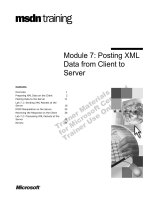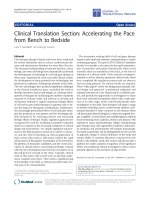American Voices How Dialects Differ from coast to coast_01 docx
Bạn đang xem bản rút gọn của tài liệu. Xem và tải ngay bản đầy đủ của tài liệu tại đây (703.12 KB, 34 trang )
American Voices
AVA01 21/7/05, 10:48 AM1
AVA01 21/7/05, 10:48 AM2
AMERICAN VOICES
How Dialects Differ from
Coast to Coast
Edited by Walt Wolfram
and Ben Ward
AVA01 21/7/05, 10:48 AM3
Editorial material and organization © 2006 by Blackwell Publishing Ltd
blackwell publishing
350 Main Street, Malden, MA 02148-5020, USA
9600 Garsington Road, Oxford OX4 2DQ, UK
550 Swanston Street, Carlton, Victoria 3053, Australia
The right of Walt Wolfram and Ben Ward to be identified as the Authors of
the Editorial Material in this Work has been asserted in accordance with the
UK Copyright, Designs, and Patents Act 1988.
All rights reserved. No part of this publication may be reproduced, stored in
a retrieval system, or transmitted, in any form or by any means, electronic,
mechanical, photocopying, recording or otherwise, except as permitted by the
UK Copyright, Designs, and Patents Act 1988, without the prior permission
of the publisher.
First published 2006 by Blackwell Publishing Ltd
1 2006
Library of Congress Cataloging-in-Publication Data
American voices : how dialects differ from coast to coast / edited by Walt
Wolfram and Ben Ward.
p. cm.
Includes bibliographical references.
ISBN-13: 978-1-4051-2108-8 (alk. paper)
ISBN-10: 1-4051-2108-4 (alk. paper)
ISBN-13: 978-1-4051-2109-5 (pbk. : alk. paper)
ISBN-10: 1-4051-2109-2 (pbk. : alk. paper) 1. English language—
Dialects—United States 2. English language—Variation—United
States. 3. English language—Dialects—Canada. 4. English language—
Dialects—Caribbean Area. I. Wolfram, Walt, 1941– II. Ward, Ben, 1962–
PE2841.A77 2006
427′.973—dc22
2005017255
A catalogue record for this title is available from the British Library.
Set in 10.5/13pt Minion
by Graphicraft Typesetters Limited, Hong Kong
Printed and bound in the United Kingdom
by T J International Ltd, Padstow, Cornwall
The publisher’s policy is to use permanent paper from mills that operate a
sustainable forestry policy, and which has been manufactured from pulp
processed using acid-free and elementary chlorine-free practices. Furthermore,
the publisher ensures that the text paper and cover board used have met
acceptable environmental accreditation standards.
For further information on
Blackwell Publishing, visit our website:
www.blackwellpublishing.com
AVA01 21/7/05, 10:48 AM4
Contents
List of Illustrations ix
Preface xi
1 Language Evolution or Dying Traditions?
The State of American Dialects 1
Walt Wolfram and Natalie Schilling-Estes
Part I The South
2 Sounds of the South 11
Guy Bailey and Jan Tillery
3 Defining Appalachian English 17
Kirk Hazen and Ellen Fluharty
4 If These Hills Could Talk (Smoky Mountains) 22
Christine Mallinson, Becky Childs, Bridget Anderson,
and Neal Hutcheson
5 Doing the Charleston (South Carolina) 29
Maciej Baranowski
6 The Lone Star State of Speech (Texas) 36
Guy Bailey and Jan Tillery
7 Speaking the Big Easy (New Orleans, LA) 42
Connie Eble
AVA01 21/7/05, 10:48 AM5
8 Sounds of Ole Man River (Memphis, TN) 49
Valerie Fridland
Part II The North
9 Yakking with the Yankees (New England) 57
Julie Roberts, Naomi Nagy, and Charles Boberg
10 Beantown Babble (Boston, MA) 63
Jim Fitzpatrick
11 Mainely English 70
Jane S. Smith
12 Steel Town Speak (Pittsburgh, PA) 77
Barbara Johnstone and Scott Kiesling
13 New York Tawk (New York City, NY) 82
Michael Newman
14 Expressions of Brotherly Love (Philadelphia, PA) 88
Claudio Salvucci
15 Maple Leaf Rap (Canada) 93
J. K. Chambers
Part III The Midwest
16 An Introduction to Midwest English 101
Timothy C. Frazer
17 Straight Talking from the Heartland (Midwest) 106
Matthew J. Gordon
18 Words of the Windy City (Chicago, IL) 112
Richard Cameron
19 Different Ways of Talking in the Buckeye State (Ohio) 118
Beverly Olson Flanigan
20 Spirited Speech (St. Louis, MO) 124
Thomas E. Murray
21 Saying Ya to the Yoopers (Michigan’s Upper Peninsula) 130
Beth Simon
vi Contents
AVA01 21/7/05, 10:48 AM6
Part IV The West
22 Getting Real in the Golden State (California) 139
Penelope Eckert and Norma Mendoza-Denton
23 Desert Dialect (Utah) 144
David Bowie and Wendy Morkel
24 Dialects in the Mist (Portland, OR) 149
Jeff Conn
25 Arizona’s not so Standard English 156
Lauren Hall-Lew
Part V Islands
26 Topics from the Tropics (Hawai’i) 165
Miriam Meyerhoff
27 Speaking Strictly Roots (West Indies) 172
Renee Blake
28 Gullah Gullah Islands (Sea Island, SC, GA) 178
Tracey L. Weldon
29 Islands of Diversity (Bahamas) 183
Walt Wolfram, Becky Childs, Jeffrey Reaser, and Benjamin Torbert
30 Dialects in Danger (Outer Banks, NC) 189
Walt Wolfram
31 Fighting the Tide (Smith Island, MD) 196
Natalie Schilling-Estes
32 From Cod to Cool (Newfoundland, Canada) 203
Sandra Clarke
33 The World’s Loneliest Dialect (Tristan da Cunha) 210
Daniel Schreier
Part VI Sociocultural Dialects
34 Bridging the Great Divide (African American English) 217
John Baugh
Contents vii
AVA01 21/7/05, 10:48 AM7
35 When Linguistic Worlds Collide (African American English) 225
Walt Wolfram and Benjamin Torbert
36 Talkin’ with mi Gente (Chicano English) 233
Carmen Fought
37 Stirring the Linguistic Gumbo (Cajun English) 238
Megan E. Melançon
38 From the Brickhouse to the Swamp
(Lumbee Vernacular English) 244
Walt Wolfram
39 More than Just Yada Yada Yada (Jewish English) 251
Cynthia Bernstein
40 Fading Future for Ferhoodled English
(Pennsylvania German) 258
Marion Lois Huffines
Notes on Contributors 264
viii Contents
AVA01 21/7/05, 10:48 AM8
List of Illustrations
1 Dialect areas of the United States, based on telephone
survey data 1
2 A group of Confederate soldiers awaits orders during
the re-enactment of a Civil War battle 11
3 A farmer hoes beans in the mountains 17
4 A creek running through the Great Smoky Mountain
National Park 22
5 Historic building in Charleston, South Carolina 29
6 A traditional Texas welcome 36
7 Bourbon Street, New Orleans during Mardi Gras 42
8 Paddle steamer docked on the Mississippi River 49
9 A row of houses on Martha’s Vineyard 57
10 Boston street scene 63
11 The joys of eating Maine lobster 70
12 Downtown Pittsburgh from the West End overlook 77
13 New York contemplating the Hudson River 82
14 Professionals in Philadelphia 88
15.1 Urban life on Toronto’s Yonge Street 93
15.2 The literacy gap 96
16 Hiding in a wheatfield 101
17.1 A typical barn in the cornbelt 106
17.2 The pattern of vowel changes known as the Northern
Cities Shift 109
18 Work on a construction project in the Chicago River
North area 112
19.1 Dusk falls in Dayton, Ohio 118
List of Illustrations ix
AVA01 21/7/05, 10:48 AM9
19.2 Traditional dialect boundaries based on the Linguistic
Atlas of the United States 120
20 St. Louis skyline and Gateway Arch 124
21 Ice fishing is a popular pastime among the “Yoopers” of
Michigan’s Upper Peninsula 130
22 Soaking up the rays in southern California 139
23 The chapel at Temple Square, Salt Lake City, Utah 144
24 Fishing on the banks of the Willamette River,
Portland, Oregon 149
25 Monument Valley, Arizona 156
26 Place of Refuge, located on the Big Island, Hawai’i 165
27 Women preparing crayfish, Jamaica 172
28 South Carolina river basin 178
29 Governor’s Island, Bahamas 183
30 Ocracoke Island 189
31 Fisherman, Smith Island, Maryland 196
32 Excavations have proven that the Vikings were
the earliest European visitors to Newfoundland 203
33 Edinburgh, Tristan da Cunha 210
34 Young man in the city 217
35 Boy in a field 225
36 Time out on the railroad tracks 233
37 Boaters at the mouth of Bayou Cane, Louisiana 238
38 Lumbee girls 244
39 Young Orthodox Jews 251
40 An Amish buggy in Lancaster County, Pennsylvania 258
x List of Illustrations
AVA01 21/7/05, 10:48 AM10
Preface
The collection of dialect profiles that led to American Voices began inno-
cently. But it was hardly by accident. In fact, it developed from a shared
vision by the co-editors of this volume. In 1997, publisher Ben Ward
launched a magazine dedicated to bringing language issues to the atten-
tion of allied service professionals and to the American public in an at-
tractive, readable format. Linguists sometimes talk about the need to make
language issues more accessible to the general public; the editors of Lan-
guage Magazine made it happen. It was a bold venture, premised on the
assumption that many people were curious about language apart from the
highly specialized field of linguistics. If the development and distribution
of Language Magazine over the last several years is any indication, the
assumption of interest was more than justified.
Meanwhile, Walt Wolfram’s sociolinguistic research over several dec-
ades taught him that just about everyone is curious about dialects. After
all, one can hardly avoid noticing and wondering about language differ-
ences in daily interactions with people from all walks of life. The problem,
however, is bridging the chasm between highly technical, microscopically
detailed studies of language variation and popular, broad-based levels of
interest. With all due respect to linguists, they often have a way of trans-
forming inherently interesting subject matter into jargon-laced presenta-
tions that are comprehensible only to the few thousand professional
linguists in the world. This collection of articles is intended to do better. It
attempts to translate the detailed research of professional dialectologists
into readable descriptions for those who are curious about language dif-
ferences but have neither the background nor the desire to be professional
linguists. We systematically attempt to cover (for the most part) a range of
North American English dialect communities, including both well-known
Preface xi
AVA01 21/7/05, 10:48 AM11
and rarely recognized cases in which speakers may not even be thought to
speak a dialect. By selecting our dialect profiles in this way, we hope to
convince readers that everyone really does speak a dialect – and that they
are all of interest. We also attempt to cover a few major sociocultural
varieties, though our focus is on regional space rather than social place.
Chapters in the book, all of which appeared originally in Language Maga-
zine, are not intended to be read in sequence since they are independent
articles that do not build on each other; in fact, we would suggest that the
reader choose articles on the basis of interest and curiosity.
The idea for this collection was born in 2000 when Ben Ward contacted
Walt Wolfram about writing an article for Language Magazine on the
unique Ocracoke dialect spoken on the Outer Banks of North Carolina.
Though Wolfram was quite happy to do so, he wondered if it might be
more appropriate to write a more general article on the state of American
dialects, and suggested that this might be followed up by an ongoing series
of articles highlighting some of the notable dialects of North American
English – and slightly beyond. The seed was planted. Germination and
cultivation of the idea was another matter. Who would write these art-
icles? Could linguists actually write trade articles without resorting to
the jargon that so frequently typified their technical descriptions? Would
they consider this a worthy venture given their active research lives? We
hope that the articles that appear in this collection answer these questions
satisfactorily.
Prominent dialect researchers on particular American English dialects
were contacted to see if they would accept the challenge of writing up
their sophisticated research for a broad-based audience. Amazingly, prac-
tically everyone accepted, despite the fact that the presentation was a jour-
nalistic challenge. The incentive was simply the offer to tell their story in
a way that might be comprehensible to their friends, family, and non-
linguist colleagues and students. The reward was seeing their story attrac-
tively presented in a glossy magazine format with cool images and rapid
turn-around time in publication. The response has been one of the high-
lights of our publishing careers. The most eminent scholars in the field
wrote their dialect stories and, in the process, also subjected themselves to
editing decisions on behalf of the audience. Happily, the authors greatly
exceeded our expectations. A great debt of thanks goes to each of the
authors, not only for their splendid contributions in terms of content and
presentation but also for being such good sports in accommodating the
editorial process sometimes necessary to ensure readability and compara-
bility. Thanks also to Sarah Coleman and Tami Kaplan at Blackwell for
xii Preface
AVA01 21/7/05, 10:48 AM12
encouraging us in this project, even though it was slightly different from
the usual book project. We hope that the collection will be of interest both
to the leisure reader interested in language differences and to under-
grad students in courses on the English language, American dialects, and
sociolinguistics.
For convenience, the articles are arranged in broad-based sections that
may stretch traditional notions of region. A section is also devoted to
island dialects, a favorite breeding ground for distinct language mainten-
ance and development, and another section is devoted to some promin-
ent sociocultural varieties. Admittedly, the collection does not include all
of the dialects that might have been covered, and we can image the reader
asking, “But what about the X dialect?” In most cases, this is probably a
valid concern, and we can only apologize for our sins of omission. We
fully recognize that there are many other regional and social dialects of
North America beyond those described here. To a large extent, coverage
was dictated by the availability of active researchers to write about the
dialects they were researching, with an eye toward regional and ethnic
representation. Since we follow a case study format, it is bound to exclude
many situations worthy of inclusion. Perhaps our oversights will inspire
the description of other worthy dialect cases so that we can produce a
second volume in the future.
If nothing else, we hope that readers will understand that American
dialects are alive and well – and that they remain every bit as interesting
today as they were during their presumed heyday, whenever that was
supposed to have been. In fact, our point is that dialects are not artifacts
of the past, but ongoing, contemporary social statements about people
and place. We also hope that some of the excitement that inspires dialecto-
logists and sociolinguists to devote their entire lives to the description of
a speech community will rub off on the reader. If these descriptions do
that, then we will have succeeded beyond our imagination. Dialects are
such fun – and such an essential part of who we are and what America is.
Don’t believe the myth that dialects in American society are dying!
Walt Wolfram
William C. Friday Distinguished Professor
North Carolina State University
Ben Ward, Editor
Language Magazine
Preface xiii
AVA01 21/7/05, 10:48 AM13
AVA01 21/7/05, 10:48 AM14
Walt Wolfram and Natalie Schilling-Estes 1
1
Language Evolution or Dying
Traditions? The State of
American Dialects
Walt Wolfram and Natalie Schilling-Estes
Atlantic
Provinces
NYC
Mid-Atlantic
W. Pa
Inland
North
Inland
North
WNE
ENE
Inland
South
Charleston
Florid
Texas South
The North
The Midland
The South
The West
Canada
1 Dialect areas of the United States, based on telephone survey data (from Labov, Ash, and
Boberg 2005). © 2005 by William Labov, Sharon Ash, and Charles Boberg from Atlas of North
American English (New York/Berlin: Mouton de Gruyter).
Most people find dialects intriguing. At the same time, they have lots of
questions about them and often have strong opinions as well. Probably
the most common question we encounter about the condition of Amer-
ican dialects is, “Are American dialects dying, due to television and the
AVC01 21/7/05, 10:48 AM1
2 Language Evolution or Dying Traditions?
mobility of the American population?” Certainly, media, transportation,
and technology have radically compressed the geography of the United
States and altered American lifestyles over the last century. So what effects
do these significant changes have on America English dialects? What about
the future of American dialects as English assumes a global role?
Basic Dialects of American English
The methodical collection of data on regional dialect variation in America
began in earnest in the 1930s when the Linguistic Atlas of the United
States and Canada was launched and dialectologists began conducting
large-scale surveys of regional dialect differences. This effort was buoyed
in the 1960s through an extensive national survey that has now led to the
publication of the first four volumes of the six-volume Dictionary of
American Regional English (Cassidy and Hall 1985, 1991, 1996, 2002),
the premier reference work on regional American English dialectology.
These surveys focused on the regional vocabulary of older lifetime
residents of rural areas and so captured a picture of dialect differences as
they existed in the late nineteenth and early twentieth centuries. The result
was a number of useful dialect maps of the primary and secondary dialect
areas of the mainland US, including the one featured at the beginning of
the chapter.
To a large extent, traditional dialect divisions in the US reflect differ-
ences first established in Colonial America by people from different parts
of the British Isles. These differences were cemented in early cultural
hubs such as Richmond, Philadelphia, Boston, and Charleston and later
diffused outward as English speakers moved inland. But do these differ-
ences still hold at the beginning of the twenty-first century, after a century
of demographic shifts, economic growth, and sociocultural change? Linguist
William Labov and his colleagues at the University of Pennsylvania are
currently conducting an extensive telephone survey of dialect pronunci-
ations throughout the US. Though still ongoing, his survey reaffirms the
persistence of the same major dialect boundaries that were established in
earlier studies. However, Labov’s research reveals more than the mere
maintenance of fundamental dialect boundaries; it shows that in some
ways the major dialects of the US are actually becoming more different
from one another rather than more alike.
AVC01 21/7/05, 10:48 AM2
Walt Wolfram and Natalie Schilling-Estes 3
In large Northern cities such as Chicago, Detroit, Cleveland, and
Buffalo, certain vowel pronunciations are changing in ways that distance
them from Southern vowels. For example, the augh sound of a word like
caught is now pronounced more like the vowel of cot. Meanwhile, a word
like lock sounds something like lack, while tack sounds a little like tech. At
the same time, Southern vowels are changing in different ways. For exam-
ple, red sounds something like raid, and fish sounds almost like feesh. So
much for the presumed homogenization of Northern and Southern speech.
Changing Trends in Dialects
The continuity and enhancement of basic dialect boundaries during a
century of demographic and social change is certainly a feature story, but
there are some sidebars that point to change in the dialects of American
English as well. Several factors have had a significant impact on the reposi-
tioning of American English dialects at the turn of the millennium. These
include changing patterns of immigration and language contact within
the US, shifting patterns of interregional movement within the US, and
expanded transportation and communication networks. To go along with
these demographic and technological developments, changes in social struc-
ture and cultural values have affected the development of dialects.
Language Contact
One factor that has always contributed to the distinctive flavor of
American English is the influence of other languages, from the earliest
Native American influences on the vocabulary of general American Eng-
lish (raccoon, moccasin, pecan, etc.), to the later influence of Scandinavian
languages on the pronunciations of the Upper Midwest, to the influence
of African languages on Ebonics. But the languages influencing American
English change as the cultural mix changes.
The languages of more recent immigrant populations from Asia and
different areas of the Hispanic world are now affecting English just as
various European languages have done throughout the history of the US.
Furthermore, new ethnic varieties of English are arising from more
recent language contact situations. For example, there are various types of
AVC01 21/7/05, 10:48 AM3
4 Language Evolution or Dying Traditions?
Hispanic English in regions of the Southwest and Southeast with heavy
concentrations of Hispanics. And these dialects are spoken not only by
those who learn English as a second language but by those whose first and
primary language is English as well.
Long-established ethnic varieties also change, as patterns of contact
among ethnic groups shift. The desegregation of ethnic communities is an
ongoing process in American society that continually brings speakers of
different groups into closer contact. However, the result of contact is not
always the erosion of ethnic dialect boundaries. Ethnolinguistic distinc-
tiveness can be remarkably persistent, even in face of sustained, daily
inter-ethnic contact. Ethnic dialect varieties are a product of cultural and
individual identity as well as a matter of simple contact. One of the dialect
lessons of the twentieth century is that speakers of ethnic varieties like
Ebonics not only have maintained but have even enhanced their linguistic
distinctiveness over the past half century. In addition, Ebonics has become
a supra-regional dialect that unites African Americans across urban and
rural areas that range from Boston to Los Angeles.
Population Movement
Dialect boundaries often follow the migratory routes of the major
population movements. Historically, the significant migrations of English-
speaking people in the US have run along east–west lines. However, the
last half of the twentieth century was characterized by some different
patterns of population movement. For example, some areas of the South
have been inundated by speakers from Midland and Northern dialect areas.
At first glance, the effect of this trend seems enormous, especially in areas
such as Miami, Houston, and the Raleigh–Durham area of North Carolina,
where Southerners are overwhelmed by non-Southerners to such a degree
that it is becoming increasingly rare in these areas to locate young people
with genuine “Southern accents.” But there are also factors that work to
counter the “dialect swamping” that may result from such situations.
Many Southerners view their dialect as a strong marker of regional
identity and a source of cultural pride. Such feelings may help preserve
certain dialect features even in the face of massive linguistic pressure from
outside groups. Dialectologist Guy Bailey and his team of researchers have
found that some Southern dialect features in Oklahoma and Texas,
including the use of fixin’ to in They’re fixin’ to go the mall, have persisted
AVC01 21/7/05, 10:48 AM4
Walt Wolfram and Natalie Schilling-Estes 5
and even spread in the face of increasing settlement by non-Southerners.
The nature of regionalized American English is certainly changing, but we
can hardly say that regional dialect forms are subsiding.
Expanding Transportation and Communication Networks
The broadening of transportation and communication networks through-
out the twentieth century now provides access to even the most remote
dialect areas. These locations were once the sites of some of America’s
most distinctive dialect traditions. A potential linguistic consequence of
this increased accessibility is dialect endangerment, in which a distinctive
variety spoken by relatively small numbers of people in a once isolated
community is overwhelmed by encroaching mainstream dialects. For ex-
ample, a number of island communities on the eastern seaboard of the US
are currently in grave danger of extinction. These communities have been
transformed from small, self-contained marine-based communities into
service-based tourist meccas in a matter of decades. The traditional dialect
features of some of these communities are receding rapidly, often within
a couple of generations. At the same time, though, some communities,
or sub-groups within a community, may maintain and even enhance
certain noticeable dialect features in order to distinguish themselves from
outsiders.
Shifting Cultural Centers
Throughout its history, the US has undergone a number of major popula-
tion shifts as its economic and social structures have changed. In the
process, its centers of cultural influence have shifted as well. In the latter
part of the twentieth century and the early twenty-first, the major stream
of population movement is no longer toward the heart of the city but into
the suburbs. As cultural centers shift, so too does the locus of linguistic
change. Important dialect changes often are now initiated in the suburbs,
not the city proper. For example, sociolinguist Penelope Eckert of Stanford
University has shown that some of the most innovative speakers in the
North are suburban teens – not people from the middle of the city. In
addition we find that dialect features may spread across geographic space
AVC01 21/7/05, 10:48 AM5
6 Language Evolution or Dying Traditions?
in different ways. Whereas some dialect features may spread out from a
central area in a fairly straightforward way, like ripples in a pond, others
may “jump” from region to region. For example, the pronunciation changes
affecting some Northern cities have been shown to spread from one
major metropolitan area to another, skipping intervening areas of low
population.
Populations in particular locales may also carve out new dialects as they
develop a sense of regional identity. Many of the earliest maps of the
United States show less dialect distinctiveness as we move from east to
west, reflecting the relatively late arrival of English-speaking groups on the
West Coast as well as increased dialect mixing during westward expansion.
But this is changing. Linguists and non-linguists alike are recognizing
quite distinctive dialects on the West Coast, including California English,
whose influence has spread among young speakers throughout the US.
One of the most distinctive features of this dialect (characterized in pop
culture as “Valley Girl Talk” or “Valley Speak”) is the pronunciation of
statements with rising rather than falling intonation, so that a statement
like “We went to the movies yesterday” sounds like a question: We went to
the movies yesterday?
American Dialects in the New Millennium
Even as some traditional American dialects recede, new ones appear,
reflecting the changing dynamics of American demography and social
structure. But the present contours are deeply embedded in the historical
origins of American English, and future developments no doubt will take
their cues from the present dialect profile. Dialects mark the regional and
cultural cartography of America as much as any cultural artifact, and there
is no reason to expect that they will surrender their emblematic role in
American life in the future.
References
Bailey, G., T. Wikle, J. Tillery, and L. Sand (1993) Some patterns of linguistic
diffusion. Language Variation and Change 5: 359–90.
Carver, C. M. (1987) American Regional Dialects: A Word Geography. Ann Arbor:
University of Michigan Press.
AVC01 21/7/05, 10:48 AM6
Walt Wolfram and Natalie Schilling-Estes 7
Cassidy, F. G., and J. Hall (1985, 1991, 1996, 2002) Dictionary of American
Regional English, Vols. I–IV. Cambridge: Belknap Press at Harvard University
Press.
Labov, W., S. Ash, and C. Boberg (2000) A Phonological Atlas of North America.
The Hague: Walter de Gruyter.
Wolfram, W., and N. Schilling-Estes (2005) American English: Dialects and
Variation, 2nd edn. Malden, MA: Blackwell.
AVC01 21/7/05, 10:48 AM7
8 Language Evolution or Dying Traditions?
AVC01 21/7/05, 10:48 AM8
Guy Bailey and Jan Tillery 9
PART I
THE SOUTH
AVC02 21/7/05, 10:48 AM9
10 Sounds of the South
AVC02 21/7/05, 10:48 AM10
Guy Bailey and Jan Tillery 11
2
Sounds of the South
Guy Bailey and Jan Tillery
2 A group of Confederate soldiers awaits orders during the re-enactment of a Civil War battle.
© by Dan Brandenburg.
Southern American English (SAE) is the most widely recognized regional
dialect of American English, but as most of its speakers know, widespread
recognition is a mixed blessing. SAE is also the regional dialect that is
most negatively evaluated. In a recent study of folk beliefs about American
dialects, Dennis Preston (1996) found that 90 percent of his respondents
AVC02 21/7/05, 10:48 AM11









